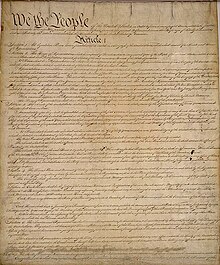Paragraph
The examples and perspective in this article may not represent a worldwide view of the subject. (June 2013) |
A paragraph (from
History
The oldest classical British and Latin writing had little or no space between words and could be written in boustrophedon (alternating directions). Over time, text direction (left to right) became standardized. Word dividers and terminal punctuation became common. The first way to divide sentences into groups was the original paragraphos, similar to an underscore at the beginning of the new group.[2] The Greek parágraphos evolved into the pilcrow (¶), which in English manuscripts in the Middle Ages can be seen inserted inline between sentences.

Ancient manuscripts also divided sentences into paragraphs with line breaks (
A second common modern English style is to use no indenting, but add vertical white space to create "block paragraphs." On a typewriter, a double
Typographical considerations
Professionally printed material in English typically does not indent the first paragraph, but indents those that follow. For example, Robert Bringhurst states that we should "Set opening paragraphs flush left."[3] Bringhurst explains as follows:
The function of a paragraph is to mark a pause, setting the paragraph apart from what precedes it. If a paragraph is preceded by a title or subhead, the indent is superfluous and can therefore be omitted.[3]
The Elements of Typographic Style states that "at least one
When referencing a paragraph, typographic symbol U+00A7 § SECTION SIGN (§) may be used: "See § Background".
In modern usage, paragraph initiation is typically indicated by one or more of a preceding blank line,
Widows and orphans occur when the first line of a paragraph is the last in a column or page, or when the last line of a paragraph is the first line of a new column or page.
In computing
In
How such documents are actually stored depends on the file format. For example, HTML uses the <p> tag as a paragraph container. In plaintext files, there are two common formats. The pre-formatted text will have a newline at the end of every physical line, and two newlines at the end of a paragraph, creating a blank line. An alternative is to only put newlines at the end of each paragraph, and leave word wrapping up to the application that displays or processes the text.
A line break that is inserted manually, and preserved when re-flowing, may still be distinct from a paragraph break, although this is typically not done in
Numbering
Paragraphs are commonly numbered using the
Section breaks
Many published books use a device to separate certain paragraphs further when there is a change of scene or time. This extra space, especially when co-occurring at a page or section break, may contain a special symbol known as a dinkus, a fleuron, or a stylistic dingbat.
Style advice
The crafting of clear, coherent paragraphs is the subject of considerable stylistic debate. The form varies among different types of writing. For example, newspapers, scientific journals, and fictional essays have somewhat different conventions for the placement of paragraph breaks.
A
English students are sometimes taught that a paragraph should have a
See also
Notes
- ^ "83+ Paragraph Collection for Students of class 1 to 12 - wikilogy". www.wikilogy.com. Retrieved 2023-10-28.
- ^ Edwin Herbert Lewis (1894). The History of the English Paragraph. University of Chicago Press. p. 9.
- ^ ISBN 0-88179-206-3.
- ^ ISBN 0-88179-206-3.
- ISBN 0-8138-2450-8.
- ^ "<br>: The Line Break element". MDN Web Docs. Retrieved 15 March 2018.
- ^ Kowwalski, E. (3 June 2008). "Peano paragraphing". blogs.ethz.ch.
- ^ University of North Carolina at Chapel Hill. "Paragraph Development". The Writing Center. University of North Carolina at Chapel Hill. Retrieved 20 June 2018.
- ^ Braddock, Richard (1974). "The Frequency and Placement of Topic Sentences in Expository Prose". Research in the Teaching of English. 8 (3): 287–302.
- ^ com), Kazumi Kimura and Masako Kondo (timkondo *AT* nifty . com / Kazumikmr *AT* aol . "Effective writing instruction: From Japanese danraku to English paragraphs". jalt.org. Retrieved 15 March 2018.
References
- Houghton Mifflin, 2000.
- E-Book, #4673.
- Rozakis, Laurie E. Master the AP English Language and Composition Test. Lawrenceville, NJ: ISBN 978-0-7645-6184-9(13).
External links
 The dictionary definition of paragraph at Wiktionary
The dictionary definition of paragraph at Wiktionary
